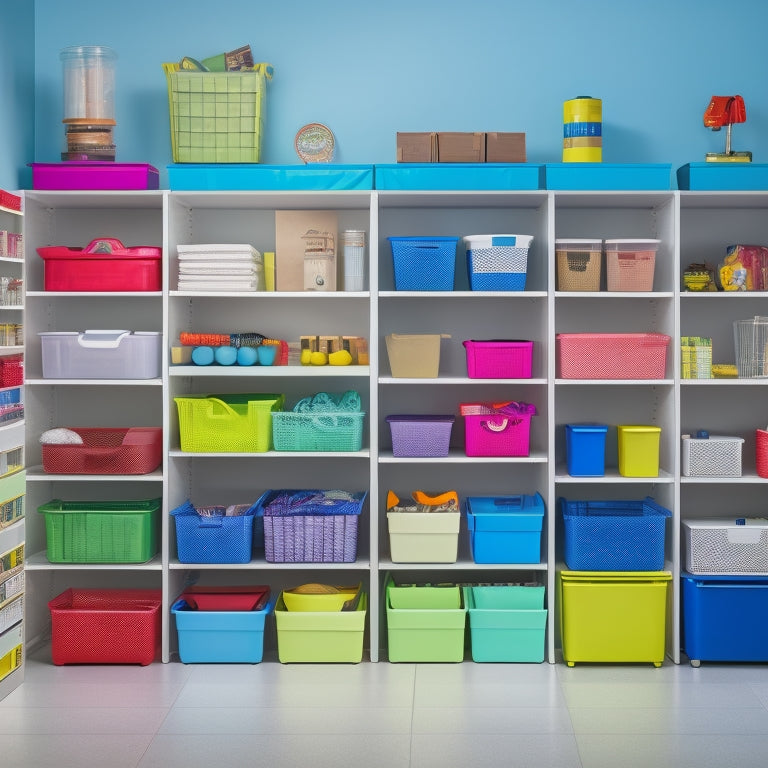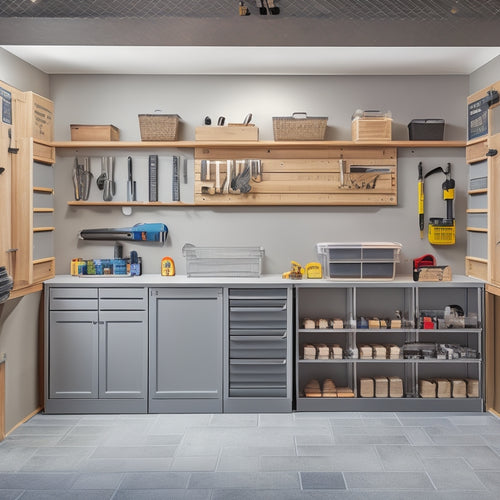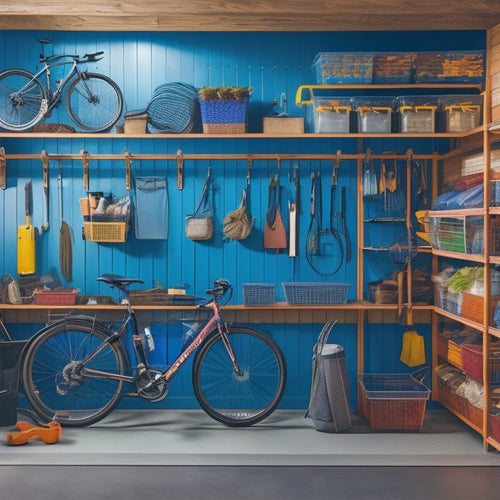
A 5-Part Guide to Organizing Bins on Shelves
Share
You'll start by evaluating your storage needs, categorizing items by type, frequency of use, and size, and measuring your shelf dimensions to determine the perfect bin fit. Next, you'll choose the right bin size, considering storage capacity and material sturdiness. Then, you'll label and categorize your bins, implementing color coding and specific labels to guarantee easy item distinction. After that, you'll maximize your shelf space efficiently by utilizing vertical storage, multifunctional bins, and strategic organization. Finally, you'll maintain your organization over time by establishing a routine maintenance schedule and making adjustments as needed - and by following these steps, you'll reveal a wealth of knowledge to optimize your storage system.
Key Takeaways
- Conduct an inventory assessment to determine storage requirements and categorize items by type, frequency of use, and size.
- Choose bin sizes that fit comfortably on shelves, considering storage capacity and obstacles like pillars or ductwork.
- Label and categorize bins by contents, using color coding and clear labels to differentiate between subcategories and prevent accidents.
- Maximize shelf space by utilizing vertical storage, adjustable shelves, and multifunctional bins, and implementing strategic organization.
- Establish a routine maintenance schedule to inspect bins and shelves, update labels, and adjust storage needs seasonally.
Assessing Your Storage Needs
Since you're planning to organize bins on shelves, start by taking stock of your storage needs. This inventory assessment will help you determine what you need to store and how much space you'll require.
Take everything out of your current storage areas and categorize items by type, frequency of use, and size. This will give you a clear illustration of what you need to accommodate.
Next, evaluate the space where you'll be placing the bins. Measure the shelves, taking note of their dimensions, including height, width, and depth.
Consider any obstacles, such as pillars or ductwork, that may affect bin placement. This space evaluation will help you determine the maximum size of bins you can use and how many you can fit on each shelf.
Choosing the Right Bin Size
When selecting bins for your shelves, you'll want to take into account the dimensions of the bins to guarantee they fit comfortably on the shelves and can hold the items you need to store.
You'll also want to think about the ideal storage capacity for each bin, as overcrowding can lead to clutter and disorganization.
Bin Dimensions Matter
Your storage shelves are ready, and now it's time to populate them with bins. But before you start, consider the bin dimensions that will work best for your space.
You'll want to choose bins that fit comfortably on the shelves, leaving enough room for easy access and removal. Measure your shelves to determine the maximum size of bin that will fit, and take note of any obstructions, like shelf dividers or supports.
When selecting bins, think about the items you'll be storing and the frequency of access. For example, if you'll be storing heavy items, choose bins with sturdy materials, like plastic or metal.
If you need to distinguish between different types of items, select bins in different colors or with clear labels. Bin materials and colors can also impact visibility and safety – for instance, using transparent bins can help you quickly identify contents, while bright colors can draw attention to hazardous materials.
Optimal Storage Capacity
A well-stocked storage system relies on bins that hold just the right amount of contents. You've got to strike a balance between having enough space for your items and avoiding wasted space. That's where ideal storage capacity comes in.
Choosing the right bin size is essential for effective space optimization. Here's a quick guide to help you get it right:
| Bin Size | Ideal Contents |
|---|---|
| Small (1-2 cu. ft.) | Small toys, craft supplies, office materials |
| Medium (2-4 cu. ft.) | Linens, towels, cleaning supplies, tools |
| Large (4-6 cu. ft.) | Bedding, seasonal decorations, luggage |
When selecting a bin, consider the size and quantity of the items you need to store. You want to leave enough room for easy access and retrieval, but not so much that the bin feels empty. By choosing the right bin size, you'll create a storage solution that's both efficient and safe. Remember, the goal is to maximize your storage space without compromising accessibility.
Labeling and Categorizing Bins
Labeling and categorizing bins is essential to maintaining an organized shelving system. You've worked hard to optimize your storage capacity, and now it's time to guarantee you can easily find what you need.
Start by categorizing your bins based on their contents, such as cleaning supplies, office materials, or crafting tools. Within each category, use color coding to differentiate between subcategories. For example, use red labels for cleaning chemicals and green labels for cleaning tools.
When labeling your bins, consider the material they're made of. Clear plastic bins are great for storing items you need to see, while opaque bins are better suited for items like paper products or linens.
Be specific with your labels, including the exact contents and any relevant instructions, such as "Fragile" or "Do Not Stack." This will prevent accidents and guarantee you're using the right bin for the job.
Maximizing Shelf Space Efficiently
Shelf real estate is a precious commodity, and maximizing it efficiently is essential to maintaining a clutter-free and organized space.
By optimizing your shelf space, you'll be able to fit more bins and items, reducing clutter and making the most of your storage area.
To maximize your shelf space efficiently, consider the following strategies:
-
Use vertical storage: Install shelves that go up to the ceiling or use stackable bins to make the most of your vertical space.
-
Invest in adjustable shelves: Adjustable shelves allow you to customize the height of each shelf to fit different-sized bins and items.
-
Choose multifunctional bins: Select bins that serve multiple purposes, such as decorative storage bins that add style to your space while storing items.
- Opt for modular systems: Modular shelving systems and bins can be easily rearranged to adapt to changing storage needs, ensuring you're always making the most of your space.
Maintaining Organization Over Time
You've optimized your shelf space, and your storage area is looking neat and organized. Now it's vital to maintain this organization over time to guarantee your space remains safe and efficient.
Establish a routine maintenance schedule to regularly inspect your bins and shelves. Check for signs of wear and tear, and make necessary repairs or replacements. This will prevent accidents and keep your storage area secure.
Seasonal adjustments are also significant. As the seasons change, your storage needs may shift. For example, you may need to store winter clothing or holiday decorations.
Update your bin labels and contents accordingly to keep your storage area organized and clutter-free. By incorporating routine maintenance and seasonal adjustments into your organizational routine, you'll be able to enjoy the benefits of your optimized shelf space for years to come.
Customizing for Unique Situations
Your storage area's unique needs require customized solutions. You may have odd-shaped items, bulky storage bins, or shelves with unusual dimensions. To maximize your space, you need to think outside the box and get creative with your storage solutions.
Consider the following scenarios and adapt your storage strategy accordingly:
-
Specialized bins: Employ bins with dividers or compartments to store small, delicate, or fragile items, such as electronics, tools, or craft supplies.
-
Adjustable shelving: Invest in shelving units with adjustable heights to accommodate bins of varying sizes or to create a tiered storage system.
-
Corner storage: Make use of corner shelves, baskets, or carousels to make the most of often-wasted corner space.
- Heavy-duty storage: Designate a section for heavy or oversized items, such as luggage, seasonal decorations, or equipment, using sturdy bins and reinforced shelving.
Frequently Asked Questions
Can I Use Bins of Different Materials, Like Plastic and Fabric, Together?
You can mix and match bins made of different materials, like plastic and fabric, as long as you prioritize bin compatibility and consider the material benefits, ensuring a safe and functional storage system that meets your needs.
How Do I Keep Bins From Sliding or Falling off the Shelves?
As you envision your perfectly organized shelves, imagine bins staying put, not teetering on the edge. To prevent this, you'll place non-slip mats under them and install adjustable dividers to keep them snug, ensuring a safe and secure storage space.
Are Clear Bins Better Than Opaque Bins for Organization?
When choosing bins, you'll want to contemplate whether clear bins are better than opaque ones for your organization needs. Clear bins offer visibility benefits, making it easy to identify contents, while opaque bins cater to aesthetic preferences, blending with your shelving style.
Can I Stack Bins With Lids That Don't Fully Open?
When stacking bins with lids that don't fully open, you'll need to prioritize lid accessibility. Develop strategic stacking techniques, like alternating bin orientations or using risers, to guarantee you can safely access contents without straining or compromising the bin's structure.
Do I Need to Leave Space Between Bins for Easy Removal?
Imagine a fire station with bins of emergency gear on shelves; you need to grab what you need fast. To guarantee easy access, you'll want to leave about an inch of space between bins, allowing you to pull them out quickly and safely without straining or forcing them.
Conclusion
You've reached the finish line, and your shelf is now a work of art of organization! Think of each bin as a puzzle piece, fitting snugly together to create a harmonious whole. Your newly organized space is like an orchestra, with every item playing its part in perfect harmony. As you step back to admire your handiwork, remember that maintaining this harmony is key. With regular tune-ups, your bins will continue to sing in perfect sync, bringing calm and clarity to your daily life.
Related Posts
-

Heavy-Duty Pegboard Hooks for Industrial Use
You need heavy-duty pegboard hooks that can withstand the rigors of industrial use, providing a reliable and efficien...
-

Essential Steps for Garage Storage System Design
You're about to change your cluttered garage into an organized haven by following a structured approach to garage sto...
-

Garage Wall Storage Ideas to Boost Productivity
You can enhance your garage's productivity by capitalizing on your ceiling height with overhead racks, storing bulky ...


